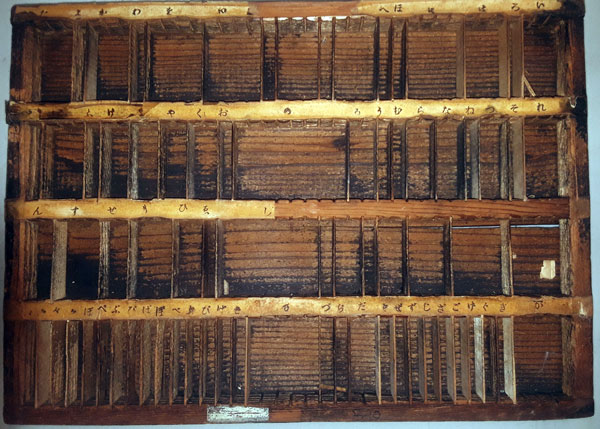
By David Yamaguchi The North American Post
As we count down the weeks to the September 1, 2022 120th anniversary of this newspaper, we find that we have learned far more about “The North American Times” (the pre-WWII predecessor of this paper) and the early NAP than we had thought possible near the start of our journey (many NAP articles since late 2021).
Yet one question has not yet been considered. How did the printing press operators store and retreive their Japanese lead type?
In answering it, we begin with the filing of the basic phonetic kana type, which was done in wooden trays. If you passed Shigaki Sensei’s first-grade class in Japanese school, you will recall that these fundamental building blocks of written Japanese comprise simple characters that generally represent consonant and vowel pairs such as “Ka, Ki, Ku, Ke, Ko, Sa Shi Su….”

In first perusing the old kana type trays, I was pleasantly surprised to find that they do not follow the conventional post-1900, Western-influenced, boring grid system described above. Instead the arrangement is that of the late Heian “Iroha” system. That is, the type was filed by their positions in the ancient poem known to have been set to paper by 1079:
Irowa nioedo
Chirinuru o
Wa ga yo tare zo
Tsune naran
Ui no okuyama
Kyō koete
Asaki yume miji
Ei mo sezu
Yoi mo sezu
(Even the blossoming flowers
Will eventually scatter
Who in our world
Shall always be?
The deep mountains of karma —
We cross them today
And we shall not have
superficial dreams
Nor be deluded)
But why did the NAT/NAP printers choose the ancient order? While we cannot possibly know until we try setting and refiling the old leaden type ourselves, my guess would be that the old sequence spread the most commonly used kana more evenly throughout the tray. This would make them more accessible. This would have been especially true if typesetters sitting side by side used multiple trays simultaneously.
With management of the kana type thus neatly filed away, we can turn to the filing of kanji, the complex ideograms Japan learned from China. Roughly 2000 kanji are needed to read a newspaper to-day. Even more were in regular use before WWII.
Here, we begin by turning to present-day kanji dictionaries such as those by Andrew N. Nelson. These arrange characters by radicals, then by stroke count. The former are standardized components, of which there are 214. Examples include the simple kanji for the sun and moon, people, fire, water, bamboo, stone, vision, walking, etc.
As a student, I remember thinking that Nelson was really smart to figure this out! Today, I realize that the approach actually comes from China.
Nelson’s Appendix I (1997) notes, “Some three centuries ago, the Chinese evolved a system of classifying their characters according to 214 basic elements or radicals… This system is still used today in Chinese, Korean, and Japanese character dictionaries…” (p. 1233).
Suffice it to say that the lead cubes bearing what look like squished bugs on their ends were deftly set and refiled with great skill by poets who labored in near-obscurity in the basement of the NAP. Such work was accomplished only one to two generations before me. Only now are many of us beginning to appreciate what they did. For while the 214-radical ordering sounds straightforward, in practice it is not!




